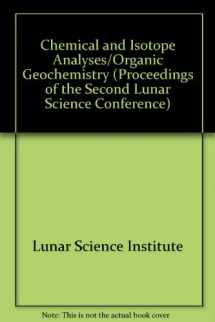
Chemical and Isotope Analyses/Organic Geochemistry (Proceedings of the Second Lunar Science Conference)
ISBN-13:
9780262120548
ISBN-10:
0262120542
Author:
A.A. Levinson, Lunar Science Institute
Publication date:
1971
Publisher:
Mit Pr
Format:
Hardcover
833 pages
FREE US shipping
Book details
ISBN-13:
9780262120548
ISBN-10:
0262120542
Author:
A.A. Levinson, Lunar Science Institute
Publication date:
1971
Publisher:
Mit Pr
Format:
Hardcover
833 pages
Summary
Chemical and Isotope Analyses/Organic Geochemistry (Proceedings of the Second Lunar Science Conference) (ISBN-13: 9780262120548 and ISBN-10: 0262120542), written by authors
A.A. Levinson, Lunar Science Institute, was published by Mit Pr in 1971.
With an overall rating of 4.2 stars, it's a notable title among other
books. You can easily purchase or rent Chemical and Isotope Analyses/Organic Geochemistry (Proceedings of the Second Lunar Science Conference) (Hardcover) from BooksRun,
along with many other new and used
books
and textbooks.
And, if you're looking to sell your copy, our current buyback offer is $0.59.
Description
The Second Lunar Science Conference was held under the auspices of the National Aeronautics and Space Administration in January 1971. Its purpose was to present the findings of some 175 Principal Investigators and their coworkers who have been engaged in studying Apollo 11 and Apollo 12 lunar rocks and soil samples, and the results of the lunar surface experiments conducted by the astronauts during their two missions to the moon. Those entrusted with the precious lunar material were selected with the same exacting care regarding their specific qualifications as were the astronauts. The Principal Investigators form an international group, representing about 15 countries. Numbered among them are such distinguished scientists as Aleksandr P. Vinogradov, vice president of the Soviet Academy of Sciences and Nobel Laureates Harold Urey and Melvin Calvin, and others of equal repute. All those who labor in the varied fields of the geological and planetary sciences will recognize within this group of contributors the acknowledged leaders in their own specialties. The 229 papers collected in these volumes cover too much lunar ground to be even itemized here. A few details on one group of studies, however, may serve to convey some sense of the whole. They were conducted by the Earth and Lunar Sciences Division of the Manned Spacecraft Center, Houston, with supporting evidence from the Smithsonian Astrophysical Observatory, Cambridge. These studies center around Rock 12013 brought back by the crew of Apollo 12. All the other rocks they gathered and all those from the Apollo 11 flight have been dated at 3.4-3.6 billion years. But like the soil samples—the "dust" from the surface—Rock 12013 is about 4.6 billion years old, or about the age of the solar system itself. An examination of its structure and content—which includes a form of granite and an exotic substance rich in potassium, rare earth elements, and phosphorus—suggests that it once existed in a very hot, molten state. The entire crust of the moon may once have consisted of such molten material, down to a depth of 100 kilometers. As it cooled and hardened this primordial crust was beaten into dusty soil by meteorite bombardment over the eons, and more recently crystallized rocks now predominate on the surface. The moon, then, may not always have been passive and inert—it may have lived through a full geological history determined to some degree by its own internal activities, perhaps including volcanic ones. The Proceedings are devoted to raising and answering questions such as these, covering every phase of lunar science. The individual papers range from broad speculations concerning the entire moon and the processes that affect it to detailed analyses of minute samples. The Universities Space Research Association is the parent organization of the Lunar Sciences Institute, which sponsored the publication of these volumes. It is estimated that only about five percent of the research results contained within them have been reported in the various journals; the rest of the material is making its first appearance in printed form.


We would LOVE it if you could help us and other readers by reviewing the book
Book review

Congratulations! We have received your book review.
{user}
{createdAt}
by {truncated_author}


